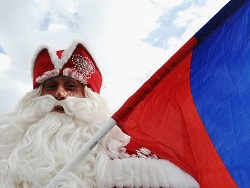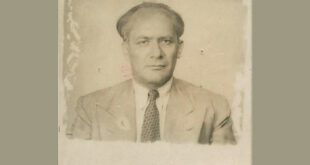
Long gone are the mythical Mongol Empire, but the Mongol-Tatars still do not allow someone to sleep peacefully. I recently remembered them in the Ukrainian Rada and… wrote a letter to the Mongolian Parliament demanding reparations for the genocide of the Ukrainian people during the invasion of Batu Khan to Kievan Rus ‘ in the XIII century.
Ulaanbaatar said the willingness to compensate the damage, but asked for clarification of the addressee in the XIII century Ukraine, it did not exist. But the press attache of the Embassy of Mongolia to the Russian Federation Lkhagvasuren Namsrai and commented ironically: “If the Verkhovna Rada will write all the names of Ukrainian citizens who fall under the genocide, their families, we will be ready to pay… looking forward To the announcement of the full list of victims”.
Historical Fortelle
Friends, jokes aside, however, the question of the existence of the Mongol Empire and Mongolia, in fact, is exactly the same as in Ukraine: was it a boy? I mean, was present at the historical stage of the mighty Ancient Mongolia? Is it because Ulaanbaatar together with Naseem so easily responded to a claim for compensation Ukraine, Mongolia in those days did not exist as Independent?
Mongolia — state education — only appeared in the early 20-ies of the last century. Mongolian people’s Republic was established in 1924, and until a few decades after this Republic as an independent state recognized only the USSR, which has contributed to the emergence of the Mongolian state. At the same time from the Bolsheviks nomads and learned that they are the descendants of the great Mongols and their “national” created in due time a Great Empire. Nomads this terribly surprised and, of course, was delighted.
The oldest literary-historical monument of the ancient Mongols considered the “Secret legend of Mongols” — the “Ancient Mongolian legend of Genghis Khan”, it compiled in 1240 by an unknown author. In a strange way preserved only Mongolian-Chinese manuscript and acquired it in 1872, in a Palace of the Beijing library head of the Russian spiritual mission in China Archimandrite Palladius. It was during this period finalized — or rather, counterfeit rewriting the history of the World and, as part of its, the history of Rus-Russia.
Why this was done — has been written, rewritten. Then European dwarfs, deprived of glorious historical past, realized a trivial truth: if there is no great historical past — it needs to create. The alchemists of history, based on its activities, the principle of “who controls the past — controls the present and the future”, rolled up his sleeves.
It was at this time emerges miraculously out of nowhere “Secret legend of Mongols” — the cornerstone of the historical version of the origin of the Mongol Empire of Genghis Khan. Where and how the manuscript appeared in the Beijing Palace library is a mystery. It is likely that this “historical document” appeared as the most “ancient” and “medieval Chronicles and writings of the” philosophers, historians, scientists in the period of active Scriptures of world history in the XVII-XVIII centuries. And discovered the “Secret legend of Mongols” in the Beijing library right after the Second opium war, when the forgery to commit was only a matter of technique.
But God was with him — a legend, let’s talk about more practical subjects. For example, the Mongol armies. Its system of organization — universal conscription, a clear structure (Tumen, thousands, hundreds and tens), strict discipline — the big questions does not cause. It’s all easy to implement things in a dictatorial form of government. However, the army became powerful and efficient, you need to be, equipped in accordance with the requirements of the current time. Primarily we are interested in equipping troops with weapons and means of protection.
According to historical studies the actual army of Mongols with Genghis Khan which went on to conquer the world, was 95 thousand people. It was armed with a metal (iron) — weapons (swords, knives, spears, arrows etc.). Plus the metal parts were armored warriors (helmets, pads, armor, etc.). Later appeared the chain mail. And now imagine what is required for the production of metal products in the scale of equipment almost hundred-thousandth army? At least, the wild nomads were supposed to have the necessary resources, technologies and production capacities.
That we from this set have?
As they say in Mongolia land buried the whole periodic table. Of many minerals especially copper, coal, molybdenum, tin, tungsten, gold, and iron ores that God is offended. Not only that they are less than nothing, so they are still poor with a Fe content from 30% to 45%. According to experts, the practical value of these deposits is minimal. This is a first.
Secondly, researchers, as I can’t find in Mongolia the ancient centres of metal production. One recent study conducted by the Professor of Hokkaido University Isao Usuki, who for several years worked in Mongolia, studying the metallurgy of Xiongnu period (3rd century BC to 3 century ad). And the result is the same — zero. And if you talk sensibly, could have a metallurgical centres for nomads. The very nature of metal production implies a sedentary life.
We can assume that the ancient Mongols metal products, which had at that time of strategic importance, imported. But for long-term military companies, during which the Mongol army was increased significantly — according to different estimations the number of the army went from 120 to 600 thousand people, it took a lot of iron, in increasing quantities and it was supposed to do to the Horde on a regular basis. Meanwhile, the story regarding iron Mongolian rivers are also silent.
The question arises: in the era of the domination on the battlefield iron weapons, the indigenous people, the Mongols — not having any serious metal production — could create the largest in the history of mankind, continental Empire?
Don’t you think it a fairy tale or a historical fantasy, written in one of the European centers of falsification?
For what it was intended? Here we are confronted with another oddity. The Mongols conquered half the world and their ISU prevailed three hundred years only above Russia. Nor over the poles, Hungarians, Uzbeks, Kalmyks, or the same tatami, namely over Russia. Why? With only one goal — a fictional entity called “Mongol-Tatar yoke” to create an inferiority complex among Eastern Slavic Nations.
In Russian Chronicles, the term “yoke” is not found. As expected, he comes from enlightened Europe. Its first traces are found at the junction of the XV—XVI century in the Polish historical literature. In Russian sources the word combination “the Tatar yoke” appears much later — in 1660-ies. And the academic form of “Mongol-Tatar yoke” clothed him already in the first quarter of the nineteenth century publisher of Atlas of European history, Christians Kruse. Book Kruse was translated into Russian in the mid-nineteenth century. It turns out the peoples of Russia, Russia learned of a brutal “Mongol-Tatar yoke” in a few centuries after its fall.
Such is the historical thing is nonsense!
Yoke, ay-y, where are you?
Get back to the starting point of the “yoke”. The first reconnaissance expedition in the direction of Russia made a Mongol detachment under the guidance of the Jab and Sabuda in 1223. The battle of Kalka on the last day of spring ended in the defeat of the combined Russian-Polovtsian troops.
A full-fledged invasion of the Mongols under the leadership of Batu Khan did in 14 years in winter. Here arises the first hitch. Exploration held in spring, military campaign in the winter. Winter objectively for many reasons not the best time for military campaigns. Remember Hitler’s plan “Barbarossa”, the war began on 22 June and the blitzkrieg against the USSR was supposed to be completed by September 30. Even before the autumn mud, not to mention the bitter Russian cold. What killed the Great army of Napoleon in Russia? General Winter!
You can sneer, say, the Baty-Khan in 1237 this tragic experience was still unknown. But she’s Russian winter and in the XIII century was the Russian winter, only maybe even better.
So, the Mongols attacked Rus ‘ in winter, the researchers estimate, no later than 1 December. What was the army of Batu Khan?
On the issue of the number of warriors running among historians from 120 to 600 thousand people. The most recognized real figure is 130-140 thousand. Every warrior under the Charter of Genghis Khan was obliged to have at least 5 horses. In fact, in the campaign of Batu Khan, according to scientists, every nomad had 2-3 horses. And now all this horse-human weight in winter, marched with a few stops on the sieges of cities 120 days from 1 December 1237 on April 3, 1238 (the beginning of the siege of Kozelsk) — an average of 1700 to 2800 kilometers (we remember, Yes, the army of Batu was divided into two groups and the length of the route they were different). Per day — from 15 to 23 kilometers. And minus the “siege” of stops — and even more: from 23 to 38 kilometers per day.
And now answer a simple question: where and how this huge horse-human mass in winter(!) found food? Especially the Mongolian steppe horses, accustomed to eat mostly grass or hay.
In winter, unpretentious Mongolian horses they forage in the desert, taking in the snow last year’s grass. But it is in the normal tebenevka, when the animal quietly, slowly, meter by meter explores the earth in search of food. Quite a different situation the horses are marching in the March, carrying out a fighting task.
A natural question about the feed Mongolian army, and, primarily, the horse part of it, numerous researchers have discussed. Why?
In fact, this problem puts a big question not only about the validity of the campaign of Batu Khan in Russia in 1237-1238 years, but also about the fact of its existence.
And if it wasn’t the first invasion of Batu Khan, where they could get some following up to 1242, which ended in Europe?
But if the Mongol invasion was not, were nowhere to be found Mongol-Tatar yoke?
On this account there are two main versions of the scenario. Let’s call it: Western and national. Will outline them schematically.
Let’s start with “West”. In Eurasia lived and prosper in health, public education Tartary that included many dozens of people. State-forming peoples were Slavic. The state was ruled by two men — Hahn and Prince. The Prince was to rule the state in times of peace. Khan (Supreme Commander) in peacetime, was responsible for building and maintaining the combat readiness of the army (Horde) and became the head of the state in time of war. Europe in that period was a province of Tartary, which the latter kept a tight grip. Of course, Europe was paying tribute to Tartary, in case of disobedience, rebellion, the Horde quickly and firmly restored order.
As you know, every Empire in your life goes through three stages: establishment, heyday and decline. When Tartary entered the third stage of its development, it exacerbated internal turmoil — strife, religious civil war, Europe at the turn of XV-XVI centuries have gradually freed from the influence of its powerful neighbor. And then in Europe began to write historical tales, in which everything is put upside down. First, for Europeans this fantasy has served as a mental technique by which they tried to get rid of the inferiority complex, the horrible memories of being under foreign fifth. And when they realized that the Eurasian bear is not so scary and menacing, went further. And in the end came to the same formula mentioned above: who controls the past — controls the present and future. And not Europe languished for centuries under powerful bear paw, and Russia — the core of Tartary — were three hundred years under the Mongol-Tatar yoke.
In the “domestic” version no Mongol-Tatar yoke is not in sight, but the Horde is present and almost the same quality. The key point in this version was the period, when Grand Prince of Kievan Rus Vladimir I Svyatoslavich was persuaded to abandon the faith of their ancestors — the Vedic tradition, and bowed to the adoption of the “Greek religion”. Vladimir was baptized himself, and organized the mass baptism of the population of Kievan Rus. It’s not a secret that over the 12 years of forced Christianization were destroyed huge number of people. All who refused to accept the new faith were killed.
In the Eastern lands managed to preserve the Vedic tradition. So in one state’s established faith. This repeatedly led to military clashes. Here is their something foreign and chronographs have qualified as a confrontation between Russia and the Horde. Ultimately baptized Rus, by that time had been influenced by the West and its powerful support, took precedence over the Vedic East and conquered most of the territory of Tartary. And then in Russia, by that time converted to Russia, began dashing time when the destruction of ancient Russian Chronicles was the beginning of a global rewriting of Russian history with German professors of millers, buyers, secerov. Read more about this in my article “the Falsifiers of Russian history to prepare a stake”.
Each of these versions has its supporters and opponents. And the front line between the adherents of the “European” version and “domestic” held at the worldview level. So everyone should decide for himself on which side he was on.








